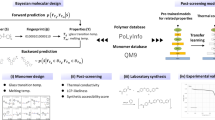Abstract
Taking advantage of techniques from the field of Computational Intelligence, the goal of our research is to construct systems that can computationally design polymer optical fiber formulations with specified desirable consumer characteristics and to develop computational tools which can be used to rationalize and predict properties of polymeric materials, such as the glass transition temperature.
This research was supported by National Textile Center (NTC) grant C05-PH01 through U.S. Department of Commerce. Various aspects appeared in publications in Conference Proceedings and in the International Journal of Intelligent Systems.
Access this chapter
Tax calculation will be finalised at checkout
Purchases are for personal use only
Similar content being viewed by others
References
Cartwright, H.M.: Applications of Artificial Intelligence in Chemistry. Oxford University Press, Oxford (1994)
Curteanu, S., Cartwright, H.M.: Neural networks applied in chemistry. I. Determination of the optimal topology of multilayer perceptron neural networks. J. Chemom. 25, 527–549 (2011)
Ballato, J., et al.: Theoretical Performance of Polymer Optical Fibers, NTC grant M01-CL01 (2001)
Van Krevelen, D.: Properties of Polymers. Elsevier, New York (1990)
Camacho-Zuniga, C., Ruiz-Trevino, F.: a new group contribution scheme to estimate the glass transition temperature for polymers and diluents. Ind. Eng. Chem. Res. 42, 1530–1534 (2003)
Marrero, J., Gani, R.: Group-contribution based estimation of pure component properties. Fluid Phase Equilib. 183, 183–208 (2001)
Katritzky, A.R., et al.: Quantitative structure-property relationship (QSPR) correlation of glass transition temperatures of high molecular weight polymers. J. Chem. Inf. Model. 38, 300–304 (1998)
Chen, X., Sztandera, L.M., Cartwright, H.M.: A neural network approach to the prediction of glass transition temperature of polymers. Int. J. Intell. Syst. 23(1), 22–32 (2008)
Author information
Authors and Affiliations
Corresponding author
Editor information
Editors and Affiliations
Rights and permissions
Copyright information
© 2014 Institute for Computer Sciences, Social Informatics and Telecommunications Engineering
About this paper
Cite this paper
Chen, X., Sztandera, L.M., Cartwright, H.M., Granger-Bevan, S. (2014). The Use of Computational Intelligence in the Design of Polymers and in Property Prediction. In: Di Caro, G., Theraulaz, G. (eds) Bio-Inspired Models of Network, Information, and Computing Systems. BIONETICS 2012. Lecture Notes of the Institute for Computer Sciences, Social Informatics and Telecommunications Engineering, vol 134. Springer, Cham. https://doi.org/10.1007/978-3-319-06944-9_14
Download citation
DOI: https://doi.org/10.1007/978-3-319-06944-9_14
Published:
Publisher Name: Springer, Cham
Print ISBN: 978-3-319-06943-2
Online ISBN: 978-3-319-06944-9
eBook Packages: Computer ScienceComputer Science (R0)




